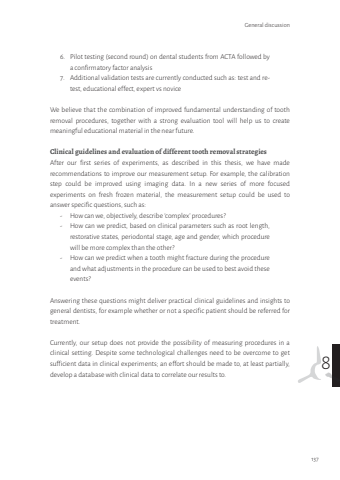Page 139 - Demo
P. 139
8General discussion1376. Pilot testing (second round) on dental students from ACTA followed by a confirmatory factor analysis7. Additional validation tests are currently conducted such as: test and retest, educational effect, expert vs novice We believe that the combination of improved fundamental understanding of tooth removal procedures, together with a strong evaluation tool will help us to create meaningful educational material in the near future. Clinical guidelines and evaluation of different tooth removal strategiesAfter our first series of experiments, as described in this thesis, we have made recommendations to improve our measurement setup. For example, the calibration step could be improved using imaging data. In a new series of more focused experiments on fresh frozen material, the measurement setup could be used to answer specific questions, such as:- How can we, objectively, describe ‘complex’ procedures?- How can we predict, based on clinical parameters such as root length, restorative states, periodontal stage, age and gender, which procedure will be more complex than the other?- How can we predict when a tooth might fracture during the procedure and what adjustments in the procedure can be used to best avoid these events?Answering these questions might deliver practical clinical guidelines and insights to general dentists, for example whether or not a specific patient should be referred for treatment.Currently, our setup does not provide the possibility of measuring procedures in a clinical setting. Despite some technological challenges need to be overcome to get sufficient data in clinical experiments; an effort should be made to, at least partially, develop a database with clinical data to correlate our results to. Tom van Riet.indd 137 26-10-2023 11:59


